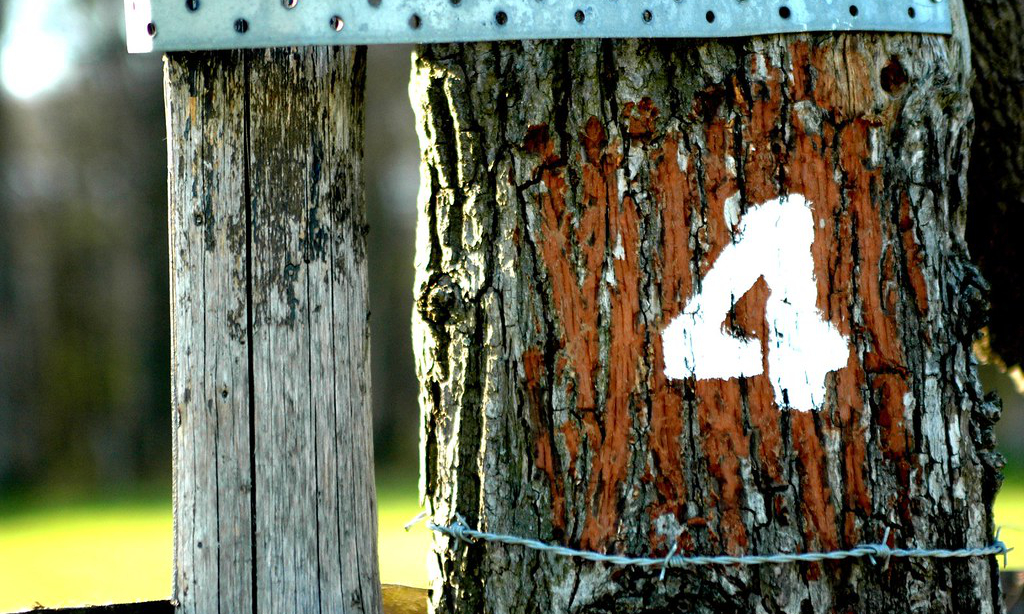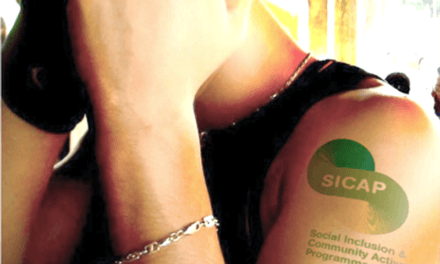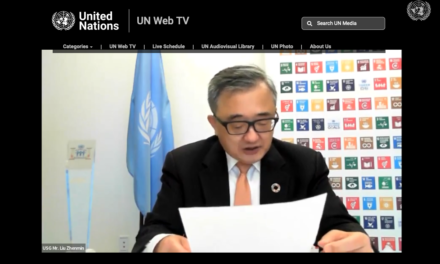Consistently showcasing successes can give those holding the purse strings confidence in the work. Some companies are already doing this, and have been able to do so on a national stage.
In a Changing Ireland opinion piece last month, Robert Carey asked why community work has to continually justify its existence. The answer? Seeing successes can give funding bodies the confidence to maintain their support, making it more important than ever for community organisations to become skilled at spinning narratives.
Storytelling in the community and voluntary sector is growing wings, as one of the sector’s main funders – the Department of Rural and Community Development – encourages groups to share their stories with the public.
Powerful regional Social Inclusion and Community Activation Programme (SICAP) case study presentations were made during the spring, which should help shape opinion and policy as they get a wider hearing. They focused on community groups and individuals whose opportunities in life are now improving.
The storytelling initiative is welcome. Most community groups have consistently ranked PR as being one of their top five priorities, but rarely get around to it.
The community sector was encouraged for years by funders – usually the State – to concentrate on statistically provable outcomes. They now increasingly recognise the power of also telling stories.
Oxfam discovered this years ago: statistics don’t lie, but they don’t move people to act in the same way stories of individuals can. You probably remember the name Alan Kurdi, but do you know how many people drowned when the most recent boat sank crossing the Mediterranean? As humans, we relate to stories about each other better than we do to stories about numbers.
Today, in a world of hate and consumerism and love and courage (hello Ruairí McKiernan), it’s only right to bombard people with our stories.
Yes, the very fact that there’s a need for community development automatically implies that something is lacking in the first place – fairly paid employment, health, sobriety, fair play or financial wellbeing.
And, of course, no government wants to hear talk of poverty, unemployment or drugs.
But our stories are about highlighting what needs to be done (and what is being done) on the ground. We never put spin on them. They are summed up in one word: solutions.
We plan to feature particular SICAP case studies in upcoming editions. If you want coverage, call us.
And don’t forget to get the news out on community radio!
4 valuable projects from Clonakilty to Cavan
There are ample statistics to prove the case for further funding for communities, but now compelling real-life stories are being highlighted to make a hurricane-strength case for more national resources for communities.
In February – on Valentine’s Day, no less – Changing Ireland met passionate people engaged in empowering communities in Waterford city, Limerick city and Clonakilty, Co Cork. We also spoke to a community worker in Cavan separate to this event (see detailed report below).
Some of the groups they work with are very vulnerable.
Waterford
The Sudanese community in Waterford, men and women, receive ongoing support. Waterford Area Partnership gave a superb account of their work engaging members of the Sudanese community. Sudanese society is much more patriarchal than Irish society, and diplomacy and respect were central to this work.
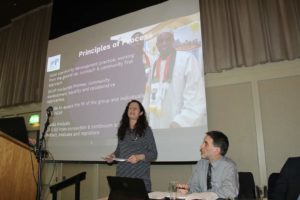
Waterford Area Partnership representative addresses audience.
West Cork
In Clonakilty, where there are numerous hotels and tourism attractions, there was no community centre. Now, they have one.
West Cork Development Partnership took – no surprise – a community development approach to setting up a community centre in Clonakilty, and that’s what made it work. Townspeople really got behind the project and gave even more donations than were needed. The centre is now open.
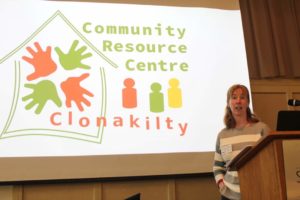
West Cork Development Partnership representative briefs crowd.
Limerick
In Limerick, people learned how to improve their wellbeing and mental health. It was life-transforming for participants and their communities.
This case-study aptly demonstrated SICAP’s impact. With the programme’s support, the PAUL Partnership developed a wellness recovery action plan for people across the city. Called WRAP (not to be confused with rap, as some thought), all the events held were oversubscribed.
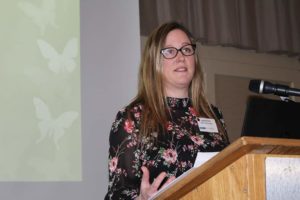
Paul Partnership representative outlines the wellness recovery plan for those gathered.
These three community initiatives were presented as detailed case-studies, and we look forward to visiting many of these projects to find out more and hear about them from the horse’s mouth.
The case-studies event, organised by Pobal and the Department of Rural and Community Development, was one of four to take place nationally. The aim? To increase awareness of the true positive impact of interventions funded through SICAP.
Hopefully, the people behind the money will hear these stories.
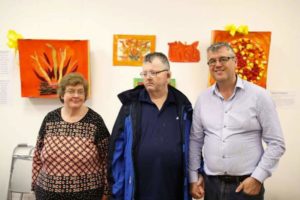
Breffni Integrated development worker Sandy Holland (on right) with art workshop participants.
‘He used to only paint using black paint; now he paints in colour’
In February, community development worker Sandy Holland told Changing Ireland about a project Breffni Integrated supports – backed by SICAP funding – that is making a big difference in the quality of life of a small number of people with disabilities in Cavan town and Virginia.
It began in 2016 when Breffni Integrated helped to set up the Cavan Disability Network, a collective of disabled people and their carers.
“One of the network’s priorities was to do something [with SICAP support] about the fact that there were limited activities for adults with disabilities,” said Holland.
The local development company entered a partnership with local day centres and sourced a feasibility grant of €5,000 from the Children and Young People’s Services Committees.
In 2017, they began holding art workshops facilitated by an art therapist and, as the year progressed, a drama and musical theatre facilitator joined the team.
With support, Cavan Disability Network applied for further funding and secured another €8,000 from the National Lottery.
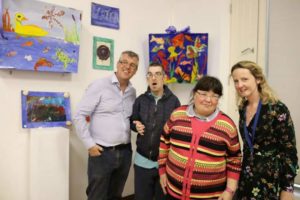
Breffni Integrated development worker Sandy Holland (far left) and arts facilitator Kim Doherty (far right) with art workshop participants.
Trust grew
In 2018, the network sought to adapt and learn.
“Trust had grown between the project organisers, care staff, workshop facilitators and the participants. More people joined the workshops and they held a public exhibition of their artwork,” said Holland.
Last year, massage therapies were introduced and had a significant impact. The project also bought musical instruments.
Pointing out that any project’s impact is magnified when organisations combine resources, Holland highlighted amazing input by care staff in supporting and encouraging nervous participants to engage in activities for the first time.
The workshop facilitators – whom he called “incredible assets” – were willing to adapt to plans that changed as they went along.
Meanwhile, the HSE found that, as a direct result of people with disabilities participating in the new activities, the health goals the HSE set out in care plans were surpassed.
There are of course challenges. For instance, the funding goes up and down and does not always arrive when expected, causing administrative headaches.
Yet the challenges are worth it. Holland called on people to look at the impact to date for participants:
– they enjoy the activities;
– they’re involved in directing the activities and are producing credit-worthy artwork and drama;
– they went to places they had no previous experience of, such as the Ramor Theatre;
– they exhibited their artwork in a proper venue, and had their work publicly acknowledged.
As Holland put it when speaking about the progress of one participant: “He used only to paint using black paint; now he paints in colour.”
The personal achievements by the participants in turn inspired the various programme partners to want to keep investing in this fabulous project.
Interested in reading more about the state of Ireland’s community development sector? Check out our latest issue.
Main photo: Herman/Flickr.com(CC BY-SA 2.0)

